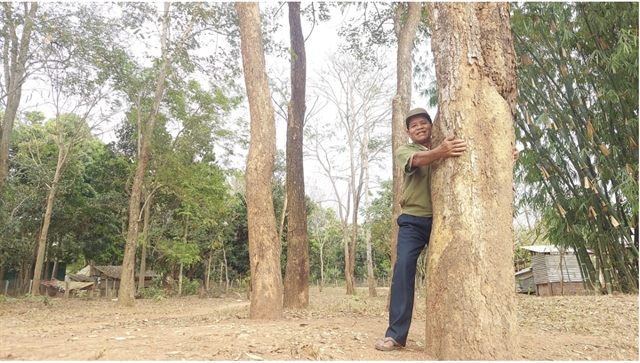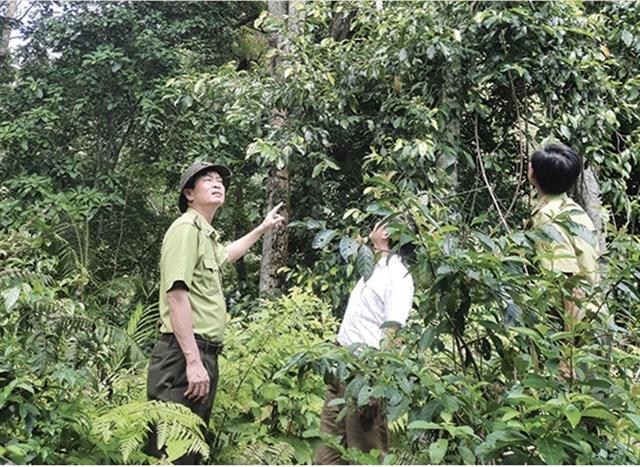 Environment
Environment

 |
| Ancient Giáng Huong (Camwood) garden of a resident in A Quan Hamlet in Lìa Commune, Hướng Hóa District of Quảng Trị Province. — Photo hanoimoi.vn |
QUẢNG TRỊ — In the ancient forests, many precious trees such as lim (ironwood), sến (mukulungu), giáng hương (camwood), although located close to residential areas, have not been cut down or damaged.
The preserved forests are a strange but true story from the southwestern region of central Quảng Trị Province.
These ancient trees are strictly protected and monitored by traditional customs, with the participation of both the living and the deceased.
Protecting forests by customs
Lìa is the name of a land in the southwestern region of Quảng Trị Province, belonging to Hướng Hóa District, encompassing communes of Thanh, Thuận, Hướng Lộc, A Xing, A Túc, Xy, A Dơi and Pa Tầng.
In this area, where high-value industrial trees are also grown, almost every commune has a sacred forest near the residential area that is always lush and green, with many precious trees. The local people, mainly the Pa Kô and Vân Kiều ethnic groups, call them their 'ghost forest'.
Elder Hồ Văn Phâng, who is 75 years old and head of Kỳ Tăng Hamlet, told hanoimoi.vn: "‘Ghost forests are places for burying the dead. According to local customs, this is a sacred place where no one can enter freely.”
In the past, the Pa Kô and Vân Kiều people believed that humans are like trees and animals in the forest, they are born, grow up and then die and since humans were protected by the forest during their lives, they should return to the forest after death to continue their connection to the other world.
Therefore, the deceased are often buried under large trees, hoping that the forest spirits will protect their souls and they consider these places to be sacred and inviolable.
"When a new village was established, the first person to die would be buried in a certain forest and that forest would then be chosen by the villagers as the 'ghost forest'”, Phâng said.
“Gradually, that forest became the resting place of ancestors, so no one is allowed to disturb it. In special cases, if someone needs to enter the 'ghost forest,' they must prepare offerings for the village elder to perform rituals and ask permission from the forest spirits.
“Wealthy families would offer a buffalo or cow, while poorer families might offer a pig or a golden rooster. If someone enters the forest without making offerings, they will be punished by the spirits, bringing misfortune to their family and the village, and they will be fined heavily with buffalo or cows," he said.
Along the Việt Nam-Lao border in Quảng Trị Province, there are dozens of 'ghost forests' near residential areas, filled with large, ancient trees some of which are so old that their trunks require two or three people to encircle them and which stand up to 40 metres tall.
These forests have been preserved for generations through traditional customs.
Hồ A Kiếp, a resident in Hướng Hiệp Commune of Đakrông District, knows many mysterious stories about the sacred forest in Khe Hiên Hamlet, which covers an area of about 100ha with many valuable ancient trees such as dổi (ford – manglietia fordiana), gõ (doussie), and huỳnh (myrobolan).
He said that the Khe Hiên sacred forest has existed for hundreds of years and he has heard many mystical tales about it.
“Each family and community member is responsible for educating and passing on the teachings of the ancestors regarding this sacred place,” A Kiếp said.
"Sacred forests do not need to be guarded because no one dares to touch them, not even to pick bamboo shoots or medicinal plants, without the permission of the village elder. Outsiders who damage the forest are punished even more severely."
Nguyễn Minh Hiền, head of the Forest Ranger Station in Hướng Hóa District, said that there are more than 1,000ha of natural forest in the Lìa area.
Among them, there are dozens of such forests, covering hundreds of hectares. They are strictly protected by traditional customs under the supervision of the local community, so many large ancient trees still exist and standing dozens of metres tall, Hiền said.
The Pa Kô and Vân Kiều people believe that these ancient trees are the dwelling places of the spirits of the deceased. Therefore, they would not dare to cut them down, even if they were offered the opportunity, he said.
 |
| Forest rangers patrol one of the ghost forests. — Photo baodantoc.vn |
Preserving for future generations
In the Lìa area, it is not only the 'ghost forests' which are protected but those in gardens and on farms, where the precious camwood trees, classified as Group IIA, which are endangered, are respected.
The tree, known as 'xa rưi' (far away) by the Vân Kiều people or 'trưi' by the Pa Kô people, can be found almost everywhere.
Hồ Văn Thứ, deputy chairman of Lìa Commune People's Committee, said that giáng hương trees are abundant in the commune and some neighbouring areas.
Some are so large that their canopies provide shade for half a hill, Thứ said.
He said that due to the shifting cultivation practices, some giáng hương have been gradually replaced by rice, corn, sweet potatoes, cassava and industrial crops.
However, many trees still remain or have been moved, with some families owning dozens of trees, while others having at least a few. Most of these trees grow naturally and were regenerated from old stumps that had been cut down before, he said.
In the garden of Hồ Xuân Deng, a 80-year-old resident in A Quan Hamlet, there are dozens of giáng hương trees. Deng planted these trees nearly 30 years ago, after digging them up from his farm.
He candidly shared that many people have come to his house, offering to buy the trees for hundreds of millions of đồng, but he firmly refused: "I am saving them for my children and grandchildren, I will not sell them."
Not only Deng, but many other families in the Lìa area also gave similar responses when asked about selling their giáng hương.
After working on his farm, Deng often hangs a hammock under the shade of the giáng hương trees to rest, sometimes gazing into the distance towards the mountains, reminiscing about the old days.
Meanwhile, family of Hồ Văn Còm in Kỳ Tăng Hamlet own more than 60 naturally growing giáng hương trees.
Còm boasted that during the blooming season, the tree's tiny flowers are fragrant.
"After the flowering season, the trees bear fruit. The older the trees, the redder and more durable the wood," said Còm.
Earning from forests
At the end of 2022, the Netherlands-Việt Nam Health Committee announced that five natural forests in Quảng Trị Province, managed by the community in Hướng Hóa District, were awarded the FSC (Forest Stewardship Council) certification and internationally recognised FSC ecosystem service certification for carbon absorption and storage, covering nearly 2,145ha of natural forest, equivalent to an annual carbon absorption of 7,000 tonnes and a total storage of 350,000 tonnes.
After receiving FSC certification, the community has strengthened forest patrols, protection and used smartphones to collect data for forest management to meet FSC requirements.
This effort has yielded positive results, as Quảng Trị Province has received tens of billions of đồng from carbon absorption and storage services.
This benefit is tied to the responsibility of preserving the sacred forests left by the ancestors of the Pa Kô and Vân Kiều people, contributing to the national sustainable forestry development programme in Quảng Trị Province. — VNS




